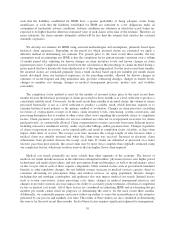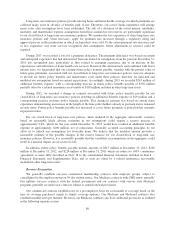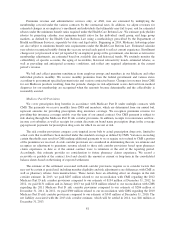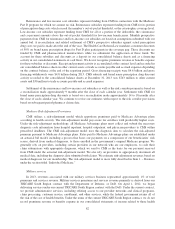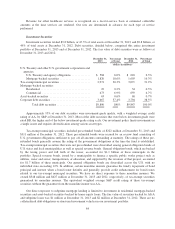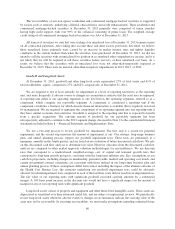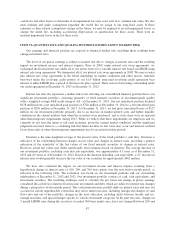Humana 2013 Annual Report Download - page 93
Download and view the complete annual report
Please find page 93 of the 2013 Humana annual report below. You can navigate through the pages in the report by either clicking on the pages listed below, or by using the keyword search tool below to find specific information within the annual report.care costs and related reimbursements. Instead, we account for revenues under the current contract net of
estimated health care costs similar to an administrative services fee only agreement. The current contract includes
fixed administrative services fees and incentive fees and penalties. Administrative services fees are recognized as
services are performed.
Our TRICARE members are served by both in-network and out-of-network providers in accordance with the
current contract. We pay health care costs related to these services to the providers and are subsequently
reimbursed by the DoD for such payments. We account for the payments of the federal government’s claims and
the related reimbursements under deposit accounting in our consolidated balance sheets and as a financing
activity under receipts (withdrawals) from contract deposits in our consolidated statements of cash flows. For the
first nine months of the new contract, April 1, 2012 to December 31, 2012, health care cost payments were $2.1
billion, exceeding reimbursements of $2.0 billion by $56 million. For 2013, health care cost reimbursement were
$3.2 billion, exceeding payments of $3.2 billion by $5 million.
Our previous TRICARE South Region contract that expired on March 31, 2012 provided a financial interest
in the underlying health care cost; therefore, we reported revenues on a gross basis. We shared the risk with the
federal government for the cost of health benefits incurred under our previous contract, earning more revenue or
incurring additional cost based on the variance of actual health care costs from an annually negotiated target
health care cost as described below. TRICARE revenues consisted generally of (1) an insurance premium for
assuming underwriting risk for the cost of civilian health care services delivered to eligible beneficiaries;
(2) health care services provided to beneficiaries which were in turn reimbursed by the federal government; and
(3) administrative services fees related to claim processing, customer service, enrollment, and other services. We
recognized the insurance premium as revenue ratably over the period coverage was provided. Health care
services reimbursements were recognized as revenue in the period health services were provided. Administrative
services fees were recognized as revenue in the period services were performed.
As indicated above, our previous TRICARE South Region contained provisions where we shared the risk
with the federal government for the cost of health benefits. Annually, we negotiated a target health care cost
amount, or target cost, with the federal government and determined an underwriting fee. Any variance from the
target cost was shared. We earned more revenue or incurred additional costs based on the variance of actual
health care costs versus the negotiated target cost. We received 20% for any cost underrun, subject to a ceiling
that limited the underwriting profit to 10% of the target cost. We paid 20% for any cost overrun, subject to a
floor that limited the underwriting loss to negative 4% of the target cost. A final settlement occurred 12 to 18
months after the end of each contract year to which it applied. We deferred the recognition of any revenues for
favorable contingent underwriting fee adjustments related to cost underruns until the amount was determinable
and the collectibility was reasonably assured. We estimated and recognized unfavorable contingent underwriting
fee adjustments related to cost overruns currently in operations as an increase in benefits expense.
Patient services
Patient services revenue associated with provider services in our Healthcare Services segment are primarily
related to Concentra. Patient services revenue includes (1) workers’ compensation injury care and related
services and (2) other healthcare services related to employer needs or statutory requirements. Patient services
revenues are recognized in the period services are provided to the customer when the sales price is fixed or
determinable, and are net of contractual allowances.
The provider reimbursement methods for workers’ compensation injury care and related services vary on a
state-by-state basis. Most states have fee schedules pursuant to which all healthcare providers are uniformly
reimbursed. The fee schedules are determined by each state and generally prescribe the maximum amounts that
may be reimbursed for a designated procedure. In the states without fee schedules, healthcare providers are
reimbursed based on usual, customary, and reasonable fees charged in the particular state in which the services
are provided. We include billings for services in revenue net of allowance for estimated differences between list
prices and allowable fee schedule rates or amounts allowed as usual, customary and reasonable, as applicable.
83





